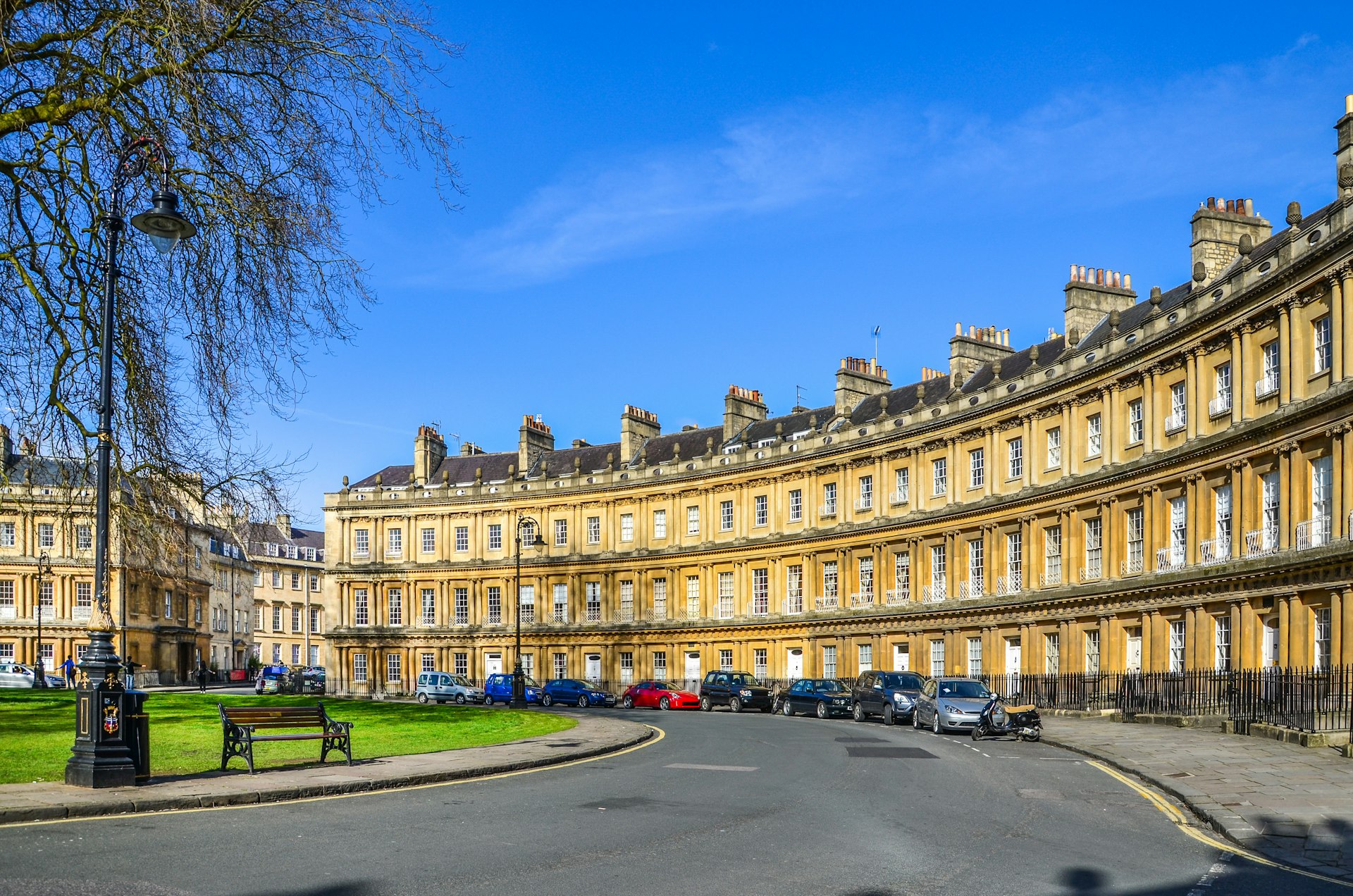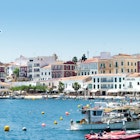With a story that stretches back more than 5000 years (and likely long before), the past is a constant presence in England. If you want to explore urban historic centers, admire mysterious monoliths, walk through scenic landscapes and enjoy rugged coastlines and national parks, then be inspired by these 16 highlights of a trip to England.
When it comes to getting around, train and long-distance bus services connect most major destinations. You may need local buses, taxi services, organized tours or your own wheels to get to the smaller places.

1. Bath
Best for Georgian architecture
In a nation packed with pretty cities, Bath still stands out as the belle of the ball. Founded by the Romans, who established the spa resort of Aquae Sulis to take advantage of the area's hot springs, Bath hit its stride in the 18th century when the rich industrialist Ralph Allen and architects John Wood the Elder and John Wood the Younger oversaw the city's reinvention as a model of Georgian architecture. Awash with golden stone townhouses, sweeping crescents and Palladian mansions, along with appealing pubs and restaurants, Bath demands your undivided attention.
2. Hadrian's Wall
Best for a long-distance walk in England
Hadrian's Wall is one of the country's most dramatic Roman ruins, its 2000-year-old procession of abandoned forts, garrisons, towers and milecastles marching across the wild and lonely landscape of northern England. This wall was about defense and control, but this edge-of-empire barrier also symbolized the boundary of civilized order – to the north lay the unruly land of the marauding Celts, while to the south was the Roman world of orderly tax-paying, underfloor heating and bathrooms. Near Newcastle you can visit Segedunum, the wall's last stronghold, for an insight into life during Roman times.
Planning tip: Hiking the full 84-mile distance coast to coast along the national trail takes around a week, but if you have less time and your own car, you may want to select from a few of the wall's highlights.

3. Brighton
Best LGBTQIA+ scene in England
It's barely an hour's train ride from the capital, but the seaside city of Brighton has a quirky character that's completely its own. Overlooking the English Channel on England's pebbly south coast, it's a city that's long been known for its oddball, alternative character. The warren of streets known as the Lanes is a good place to soak up the vibe; sprinkled with vegan cafes, espresso bars, chaotic pubs, record stores and bric-a-brac shops, it's a browser's dream come true – especially at local institution Snooper’s Paradise. You'll also find the UK's biggest queer scene here, and the region's best small clubs. The highlight for the sightseeing visitor is the Royal Pavilion, a 19th-century party palace built by the Prince Regent, who kicked off Brighton’s love of the outlandish.

4. London
Best for art, museums and culture
Waist-deep in history, London's rich seams of eye-opening antiquity appear at every turn. The city's architecture pens a beguiling biography, and a multitude of buildings – the Tower of London, Westminster Abbey, Big Ben – are instantly recognizable landmarks. It's also a tireless innovator of art and culture, a city of ideas and imagination. Visit world-class museums such as the British Museum, Natural History Museum and the Science Museum, and be dazzled at art galleries, including Tate Modern, Tate Britain, the National Gallery and the recently reopened National Portrait Gallery, all of which are free to visit. However you budget your time and money in London, make sure you take in a show.
Local tip: Big names perform in the West End (London’s equivalent of Broadway), and on the South Bank at the National Theatre and the Old Vic while smaller theatres from the Almeida to the Lyric Hammersmith are places to discover up-an-coming talent.
5. Stonehenge
Best for ancient history
Mysterious and compelling, Stonehenge is England's most iconic ancient site. People have been drawn to this myth-laden ring of boulders for more than 5000 years, and we still don't know quite why it was built. An ultramodern makeover at ancient Stonehenge has brought an impressive visitor center and the closure of an intrusive road (now restored to grassland). The result is a strong sense of historical context, with dignity and mystery returned to an archaeological gem. Most visitors gaze at the approximately 25-ton stones from behind the perimeter fence, but with enough planning, you can arrange an early-morning or evening tour and gain access to the inner ring itself. In the slanting sunlight, away from the crowds, it's an ethereal place. This is an experience that stays with you.

6. The Peak District
Best for outdoors enthusiasts
Curiously, you won't find many peaks in the Peak District. But you will find blissful miles of tumbling moorland, plunging valleys, eroded gritstone crags, lush farmland and ancient pocket-sized villages. This beautiful landscape attracts a veritable army of outdoor enthusiasts – cyclists, hikers, cavers and rock climbers – on summer weekends, while those seeking more relaxing enjoyment can admire the rural market and famous puddings of Bakewell, the Victorian pavilions of spa-town Buxton, and the architectural drama of Chatsworth House – the “Palace of the Peak.”
7. The Cotswolds
Best place for quaint villages
The Cotswolds, a tangle of impossibly-quaint villages of rose-clad cottages and honey-colored stone, is a region spreading over six English counties. It's a designated Area of Outstanding Natural Beauty, and the most wonderful thing about it is that no matter where you go or how lost you get, you'll still end up in a spot with a charming village green, a pub with sloping floors and fine ales, and a view of the lush green hills. Crisscrossed by long-distance trails including the 102-mile Cotswold Way, these gentle yet dramatic hills are perfect for walking, cycling and horse-riding.
Local tip: It's easy to leave the crowds behind and find your very own slice of medieval England here – and some of the best boutique hotels in the country.
8. Oxford
Best for riverside pubs and student life
And while in the Cotswolds, try to visit nearby Oxford. This is as close as most of us will get to the brilliant minds and august institutions that have made this city famous across the globe. You'll catch a glimpse of this rarefied world in the cobbled lanes and ancient quads where cycling students and dusty academics roam. The beautiful college buildings, archaic traditions and stunning architecture have changed little over the centuries, coexisting with a lively, modern, working city. As befits a city of students and professors, Oxford is one of the last bastions of the great British pub, with irresistible old pubs dotted down its central lanes and alleyways.

9. Cambridge
Best place for a college touring
Highlights of England’s other great historic university city, Cambridge, include a tour of at least one of the ancient colleges, and time spent marveling at the intricate vaulting of King's College Chapel. But no trip to Cambridge is complete without an attempt to take a punt (flat-bottomed boat) along the River Cam by the picturesque Backs – the leafy, green lawns behind the city's finest colleges, offering the best views of the exquisite architecture. Polish off the day with a pint in one of Cambridge's many rustic pubs.
10. Liverpool
Best place for industrial history
It's hard not to be infected by a Liverpudlian's love for their own city. For decades this was a hardscrabble town beset by all manner of social ills, but still the love endured, finding its expression in a renowned gallows humor and an obsession with football. With some of the most passionate crowds in the country, taking in a game at either Liverpool FC or Everton FC is a rite of passage here. The waterfront is once again the heart of Liverpool. The focal point is Albert Dock, an iconic docklands flanked by protected buildings, including a batch of top museums. The Merseyside Maritime Museum and the International Slavery Museum ensure the good and bad sides of Liverpool's history are not forgotten, while the Tate Liverpool and the Beatles Story museum celebrate popular culture and the city's most famous musical sons (still).

11. York
Best for the highlights of English history
With its Roman and Viking heritage, ancient city walls and maze of cobbled streets, York is a living showcase for the highlights of English history. A magnificent circuit of 13th-century walls encloses a medieval spider's web of snickelways (narrow alleys), each one the focus of a ghost story or historical character. At the city's heart lies the immense, awe-inspiring York Minster, the biggest medieval cathedral in all of northern Europe, and one of the most beautiful Gothic cathedrals in the world. Admire the exhibits from more recent times at the National Railway Museum, the world's largest collection of historic locomotives. York's long history and rich heritage is woven into virtually every brick and beam, and the modern, tourist-oriented city – with its myriad museums, restaurants, cafes and traditional pubs – is a carefully-maintained heir to that heritage.
Local tip: Enjoy some of the finest views of York from the old city walls, particularly the bucolic section behind the Minster.
12. The Lake District
Best place for literature lovers
William Wordsworth and his romantic friends were the first to champion the charms of the Lake District and it's not hard to see what stirred them. Already the UK's most popular national park, the Lake District also became a Unesco World Heritage Site in 2017, recognizing its long history of hill-farming – but for most people it's the chance to hike the humpbacked fells and drink in the gorgeous scenery that keeps them returning year after year. It's awash with outdoor opportunities, from lake cruises to mountain walks, but many people visit for the region's literary connections. Among the many writers who found inspiration here in addition to William Wordsworth were Samuel Taylor Coleridge, Arthur Ransome and, of course, Beatrix Potter, a lifelong-lover of the Lakes.

13. Whitby
Best place for haunting
Wonderful, a little weird and occasionally weather-beaten, the classic northern seaside town of Whitby has haunted lanes, fossil-hunting and arguably England's finest fish and chips. The huddle of 18th-century fisher's cottages along the East Cliff are testament to its longtime role as a busy commercial and fishing port – it was here that 18th-century explorer Captain James Cook earned his sea legs. The genteel Victorian suburb atop the West Cliff are a clue to Whitby's place as a traditional seaside resort complete with sandy beach, amusement arcades and promenading holidaymakers. Keeping a watchful eye over the town and the River Esk that divides it is an atmospheric ruined abbey, the inspiration and setting for part of Bram Stoker's Gothic horror story Dracula. But tales of witchery and ghostly legends have haunted Whitby ever since Anglo-Saxon St Hilda landed here to found a monastic community in 657 CE.
Planning tip: The town embraces its pseudo-sinister reputation, which culminates in two hugely successful Goth Weekends each year.
14. The Eden Project
Best for learning about the environmentalism
Looking like a cross between a lunar landing station and a James Bond villain's lair, the gigantic hemispherical greenhouses of the Eden Project have become a symbol of Cornwall's renaissance. Built in an abandoned clay pit near St Austell to mark the start of the new millennium, and now considered one of Britain's modern architectural wonders, the Eden Project aims to explore issues of environment and conservation, and point the way to a cleaner, greener future for us all. Exhibits cover everything from global warming to rubber production and chocolate-making. The glass-domed "biomes" recreate major world climate systems in microcosm, from the lush jungles of the Amazon rainforest (complete with treetop walkway winding through the canopy) to the olive trees, citrus groves and colorful flowers of the Mediterranean, South Africa and California. It's incredibly impressive as well as educational and inspiring
15. The Seven Sisters
Best for easily accessible views
Dover's iconic white cliffs grab the most attention, but the colossal chalky walls of the Seven Sisters are a much more spectacular affair. This four-mile roller-coaster of sheer white rock rollicks along the Sussex shore overlooking the waters of the English Channel, an impressive southern border to the South Downs National Park and most dramatic at the towering headland of Beachy Head. Hikes through the grassy clifftop fields provide wide sea views, breathtaking in every sense.
Local tip: Stop for a breather at the tiny seaside hamlet of Birling Gap where the secluded beach is a sun-trap popular with locals and walkers.

16. Stratford-upon-Avon
Best to see a Shakespeare show
The pretty town of Stratford-upon-Avon is where William Shakespeare was born and later shuffled off this mortal coil. Today it's tight knot of Tudor streets form a living map of Shakespeare’s life. Huge crowds of thespians and theater-lovers come to take in a play at the famous Royal Shakespeare Theatre. Visit the five historic houses owned by Shakespeare and his relatives, and the schoolroom where he was educated, then take a respectful detour to the old stone church where the Bard was laid to rest.
Destination expert James March reviewed and updated this text for accuracy and relevance. Some content has been adapted from Lonely Planet's print edition.














